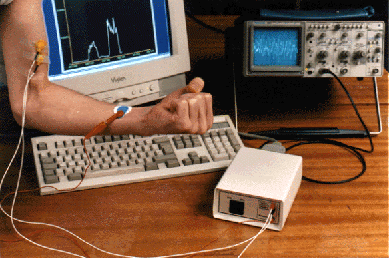Design team members: Jae Yoon Kim, Eric Lim, Min Chol Kweon
Supervisors: Prof. Maud B. Gorbet
Background

Today people are interested in design systems that require less and less hardware components and have intuitive user interface. With such a growing interest, a system that can interpret human muscle movements as an input and control things using this input can be eye-catching to many consumers. In order to achieve this, a technique called electromyography, EMG, is used to record the electrical activity produced by skeletal muscles [1]. This unique characteristic of processing input to the computer interface can be applied to control portable media players. Using the EMG technique, a portable music player such as a MP3 player can be controlled without needing any physical interactions with the device’s screen. This is especially useful when the users need to minimize unnecessary arm movements. Today, many MP3 players such as Apple IPods have touch screen user interface which needs direct physical interaction with the device’s screen. As a result, when walking or jogging on a street, it is inconvenient to control MP3 player without stopping or slowing down since users usually place their MP3 players inside their pockets. Ultimately, the design should bring more convenience to many peoples’ daily life.
Project description
The objective is to substitute physical interactions with portable music player’s UI screen by using EMG signals from human motions. In a sense, the user’s body is a controller and his/her motions serve as input to the device. Instead of controlling media players by pressing buttons with fingers, the design should enable users to control their players to play, stop or skip their music, by recognizing a set of preconfigured muscle contractions. The users can be anyone who is interested in the idea of using human body as an input device for applications, as long as they are capable of making sufficient muscle contraction. More specific objectives are that the device should:
- collect raw EMG signals from the user,
- process the raw signal (i.e. removing noise, amplification, rectification and enveloping),
- convert analog signal into digital signal,
- send data via wireless connection (Bluetooth)
- interpret the data to control media player.
Design methodology
The final design can be divided into two main parts:
- Electrical circuit: EMG signal capturing device
- PC Program: Interpolation of the signal
First, electrical circuit is used to capture EMG signal. The raw EMG signal is almost unusable at is initial state, so some signal processing is required. The processes include amplify, rectify, envelope, filter, and compare. The resulting signal would indicate whether the muscle is in tension or not. This information is collected by Basic Stamp with Bluetooth module, and it is sent to the corresponding PC wirelessly. For example, when a muscle is in tension, the corresponding signal would be 1, and when not in tension, signal would be 0.
Second, the information received by the PC is interpolated by a computer program. This program would allow users to connect the EMG signal capturing device with the PC, and determine how the EMG signals would be used. For example, twisting the forearm left would trigger the media player to skip to the previous song.